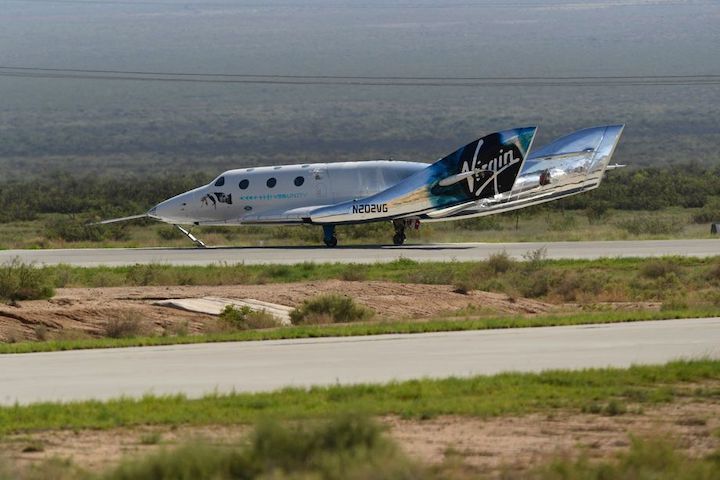2.09.2021
Branson’s flight to space was lauded as a total success, but a new report indicates otherwise

Richard Branson’s July flight to the edge of space is under investigation by the Federal Aviation Administration for veering out of its designated airspace mid-flight, the FAA said on Wednesday after a report from The New Yorker. The mission’s two pilots were alerted to yellow and red light warnings mid-flight that, according to sources in The New Yorker, should’ve prompted them to abort the mission. The flight continued and ultimately landed safely.
Virgin Galactic’s SpaceShipTwo spaceplane air-launched from its carrier aircraft on July 11th carrying founder Branson and three company employees over the firm’s New Mexico spaceport, Spaceport America. The rocket plane soared 53.5 miles high, skimming the edge of space for a few minutes of weightlessness before free-gliding back to a runway, using the rocket-propelled momentum from its ascent. Branson and the company lauded the mission as a success shortly after, with the company’s president Mike Moses telling reporters “the ship looked perfect” at touchdown.
But as the space plane was accelerating toward peak altitude, the two pilots, Dave Mackay and Michael Masucci, saw cockpit warnings that indicated the ship wasn’t flying as steeply as it should have been. Such warnings “should scare the crap out of you,” Masucci was quoted by The New Yorker as saying in a 2015 meeting with other company pilots. That gave the pilots two options, per company procedures: “implement immediate corrective action, or abort the rocket motor,” the magazine reports. Triggering an abort and returning Branson and his crew to ground without reaching space would’ve been the safest option at the time, multiple sources told Nicholas Schmidle, the article’s author who also published an exhaustive book on Virgin Galactic’s history earlier this year.
The July flight fulfilled Branson’s long-held goal to travel to space. Branson, originally slated to fly on a later mission, moved up his flight soon after Jeff Bezos announced he’d fly on his space company Blue Origin’s rocket in July. Virgin Galactic has said safety is its top priority and Branson has denied that Bezos’ rival jaunt to space played a role in his decision to launch sooner than planned.
In a statement, a Virgin Galactic spokesperson said the crew was never in any danger, the “change in trajectory” was caused by high-level winds and that the company disputes what it considers “misleading characterizations and conclusions” in The New Yorker story. “Our pilots responded appropriately to these changing flight conditions exactly as they have been trained and in strict accordance with our established procedures,” the spokesperson said. “Although the flight’s ultimate trajectory deviated from our initial plan, it was a controlled and intentional flight path that allowed Unity 22 to successfully reach space and land safely at our Spaceport in New Mexico.”
“During its July 11, 2021 flight, the Virgin Galactic SpaceShipTwo vehicle deviated from its Air Traffic Control clearance as it returned to Spaceport America,” a spokesperson for the FAA said in a statement. “The FAA investigation is ongoing.”
The off-course descent isn’t Virgin Galactic’s first brush with danger. In 2014, the company suffered a mid-flight disaster during a test flight that killed one pilot and severely injured another. After that, Branson vowed to fly aboard the ship himself before flying paying customers, as a show of confidence in the vehicle’s safety. In another test flight in 2018, with Mackay and Masucci as pilots, SpaceShipTwo veered out of control, spinning and tumbling mid-air before the pilots regained stability and landed safely, Schmidle reports. The cause was later found to be a manufacturing defect that took months to fix. After the plane flew again in 2019, engineers found significant damage to a crucial part of the plane, with a glue-like material ripped up and exposing a large gap, Schmidle wrote in his book.
Schmidle’s New Yorker story also revealed that Virgin Galactic’s former lead test pilot and flight test director, Mark Stucky, was fired eight days after Branson’s flight in the wake of revelations from Schmidle’s book. Stucky previously wrote on LinkedIn that he didn’t leave on his own terms, but the reason for his departure had been unclear. That marked the second departure of a senior safety-related employee for the company — Todd Ericson, a retired Air Force Colonel and Virgin Galactic’s former VP of safety and test, resigned from the company shortly after the 2019 test flight, frustrated with the Virgin Galactic’s safety culture, according to Schmidle.
After Virgin Galactic’s statement cast The New Yorker’s sourcing as misleading, Stucky, a veteran Air Force pilot, wrote on Twitter that “the most misleading statement today was Virgin Galactic’s.”
“The facts are the pilots failed to trim to achieve the proper pitch rate, the winds were well within limits, they did nothing of substance to address the trajectory error, & entered Class A airspace without authorization,” Stucky said. “But if that’s their definition of proper procedures and safety being paramount, well there you have it.”
Virgin Galactic’s next crewed mission, which will also be its first revenue-generating flight, is slated for late September carrying three members of the Italian Air Force. FAA investigations into unexpected flight events usually keep future missions from taking place until the agency’s inquiry is complete and any potential corrections are made by the company. But the FAA’s probe into the Unity 22 mission “has no impact on future test flights,” the Virgin Galactic spokesperson said.
Update, September 1st, 8:32PM ET: Adds a statement from a Virgin Galactic spokesperson
Update, September 2nd, 9:15AM ET: Adds tweets from Mark Stucky, Virgin Galactic’s former lead test pilot and flight test director, disputing the company’s statement
Quelle: The Verge
